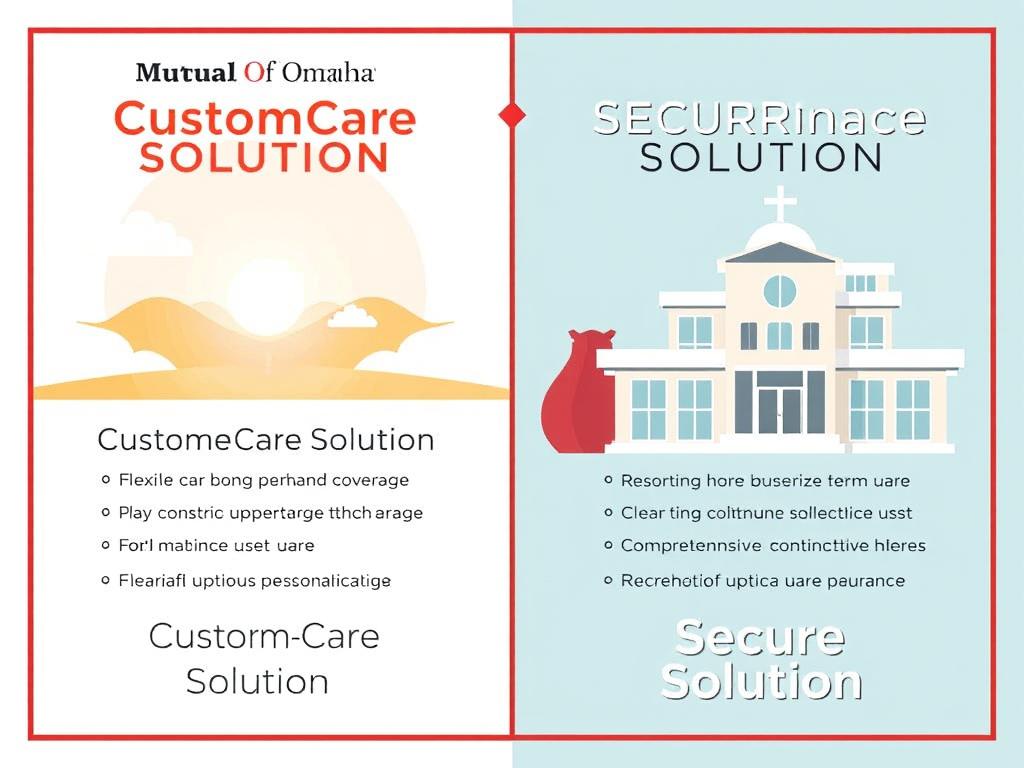You need a clear plan for paying for care as you age. Someone turning 65 today has nearly a 70% chance of needing help with daily tasks. Men average 2.2 years of care and women 3.7 years, and the median cost for a private nursing room topped $116,800 in 2023.
This guide explains why care insurance matters now and what a solid policy can do for your future. Mutual of Omaha has offered insurance since 1909 and carries strong ratings from A.M. Best, Moody’s, and S&P. That longevity matters when benefits and claims must be reliable.
You’ll learn how coverage can pay for services at home or in facilities, ways to tailor benefits and premiums, and the two core product paths that many policyholders choose. Use this section to map risks, compare features, and start planning with confidence.
Key Takeaways
- Nearly 7 in 10 people turning 65 will need some form of long-term care.
- Costs can be high; a policy helps protect savings and family resources.
- Mutual of Omaha’s history and ratings support reliable claims and service.
- Coverage can fund home care, facility care, and care coordination services.
- Understanding benefits, premiums, and benefit duration helps you choose wisely.
Why Long-Term Care Planning Matters Now
Acting today to plan for care reduces stress and keeps more choices open for where you live and who helps you. You face real odds: HHS reports nearly 70% of people who reach age 65 will need long-term care during their lives. Men average 2.2 years of care; women average 3.7 years.
Your likelihood of needing care and the real cost of services
The cost matters. Genworth’s 2023 survey lists the median private-room nursing home cost at about $116,800 per year. That level of expense can quickly deplete savings and affect family budgets.
What long-term care includes
Care ranges from non-skilled help at home—bathing, dressing, medication reminders—to supervised settings like assisted living, nursing home stays, and adult day care services.
| Service | Typical Care | Average Years | Cost Factor |
|---|---|---|---|
| Home care | ADL help, respite, home modifications | 1–4 years | Hourly or weekly |
| Assisted living | Support with daily living, oversight | 1–3 years | Monthly rent + services |
| Nursing home | 24/7 skilled and custodial care | 1–5 years | Highest annual cost |
How insurance helps protect your assets and family
Insurance fills gaps that Medicare won’t cover and can keep you from spending down assets for Medicaid eligibility. Benefits can fund home care, facility stays, or care coordination.
Planning ahead helps you pick a policy that matches your health, budget, and desired living arrangements, easing the burden on loved ones and protecting your savings.
Who Mutual of Omaha Is and Why It’s Trusted
When your future care depends on promised benefits, the insurer’s strength matters. You want an issuer with deep financial backing, consistent service, and broad reach.
A century of stability: history, financial strength, and ratings
Mutual of Omaha was founded in 1909 and ranks 328 on the 2025 Fortune 500 list. That history matters when claims extend over many years.
The company holds strong ratings: A+ from A.M. Best, A1 from Moody’s, and A+ from S&P Global. These grades support confidence that benefits and obligations are backed by solid capitalization.
Nationwide coverage and partnership policy availability
Mutual of Omaha offers long-term care insurance in all 50 states and provides partnership policies where state rules allow. Partnership options can help protect assets if you later apply for Medicaid after using benefits.
Practical value: nationwide coverage gives you flexibility if you move, and a stable insurer can make the application and claims process smoother.
| Feature | What it Means | Why it Helps you |
|---|---|---|
| Founded | 1909 | Decades of claims experience |
| Financial ratings | A+ (A.M. Best), A1 (Moody’s), A+ (S&P) | Stronger likelihood benefits are paid |
| Coverage | All 50 states + partnership policies | Flexibility and asset protection |
long-term-care-insurance-mutual-omaha: Comparing MutualCare Custom Solution vs. Secure Solution
Choosing between these two MutualCare designs starts with how much control you want over benefits and future growth.

At-a-glance differences
Custom Solution is highly customizable. You get extra elimination period choices, flexible benefit years (up to about 8.3 years), return-of-premium options, and an increased cash benefit (about 40%).
Secure Solution bundles robust built-in features. It includes a roughly 30% cash benefit and a compounding 20-year inflation option at 3% or 5% to help manage premiums for older buyers.
Inflation, spousal features, and discounts
- Inflation: Custom offers a buy-up that lets you increase inflation later regardless of insurability (to age 74 or 20 years); Custom also supports compounding for 10, 15, or 20 years.
- Spousal: Both plans include shared care, joint waiver of premium, and survivorship options for couples.
- Discounts: Up to 30% if both apply, 15% for one-applicant couples, and 15% preferred health.
Coverage and value
Both policies are tax- and partnership-qualified and cover home care, assisted living, adult day care, and nursing services. Choose Custom for maximum flexibility or Secure for simpler, strong built-in benefits.
Key Features and Benefits That Shape Your Policy
A clear set of built-in features and riders shapes how your policy pays for care and protects savings. Your starting choices — monthly benefit, total benefit pool, and benefit split for home, assisted living, or nursing facility — determine practical protection.
Coverage settings and benefit structure
Choose monthly benefits from $1,500 to $15,000 and pools from $50,000 to $500,000. You can adjust levels by service type so home care, assisted living, and nursing are funded where you expect to use them.
Care coordination and supportive services
Case management and care coordination streamline services and reduce family burden. Respite, hospice, home modifications, and medical alert systems help keep you safe and supported at home.
Cash, alternative care, and travel options
Policies include a smaller cash benefit for situations without invoices and alternative care options for new therapies. International coverage is available in the U.S., Canada, the U.K., and up to one year elsewhere.
Protective riders and premium handling
Look for joint or dual waiver of premium, survivorship options, bed reservation, return of premium at death (before age 65), and elimination periods from 0 to 365 days. These features help you balance premium cost and first-dollar protection.
Eligibility, Underwriting, and What Affects Your Premiums
What underwriters review—and when you apply—can change approval odds and the final premium you see.
Who typically qualifies: age, health, and current care needs
You cannot already be receiving care to qualify. Applicants with well-managed conditions often remain eligible.
Older applicants, especially in their 70s, face higher premiums and extra checks. For ages 65 and up, Mutual of Omaha requires an in-person assessment that includes a cognitive evaluation.
Underwriting approach, rate classes, and cognitive assessments
Mutual uses a conservative underwriting model with four rate classes. Family history matters: two first-degree relatives with dementia can disqualify you. One relative may only block preferred rates.
“Organize your medical records and medication list to present a clear health picture.”
Managing cost: inflation strategy, elimination period, and timing your application
Timing is powerful. Buying in your 40s, 50s, or early 60s often yields better rates and more options.
Use cost levers: choose an elimination period (0–365 days), pick an inflation option later if available, and size benefit pools to match likely home or facility needs. Balance premiums with assets so your coverage protects savings while remaining affordable.
Conclusion
Plan now, Selecting the right insurance path helps you pay for care on your terms.
You’ve seen how a solid care insurance choice can protect savings and offer reliable benefits for home or facility services.
Mutual Omaha provides two clear routes: choose Custom Solution for flexibility or Secure Solution for built-in simplicity. Match coverage and benefit pools to local costs and your priorities.
Work with a Long-Term Care Insurance Specialist to compare premiums, navigate underwriting, and file a strong application. Doing so lets you lock in protection that helps pay care and eases the load on family while safeguarding your assets.
FAQ
What does Mutual of Omaha’s long-term care insurance cover?
Mutual of Omaha’s policies typically cover a range of services including in-home care, home health aide visits, assisted living facility costs, nursing home care, and adult day services. Many plans also include care coordination, respite for family caregivers, and certain home modifications. Coverage specifics depend on the policy you choose and the benefit options you select when you apply.
How do the Custom Solution and Secure Solution plans differ?
The Custom Solution emphasizes flexibility and customizable benefit design, letting you tailor monthly benefits, benefit pools, and elimination periods. The Secure Solution focuses on streamlined choices with clear pricing. Key differences include available inflation options, shared care features for spouses, and the range of discounts—so compare plan details to match your budget and care goals.
What inflation protection options are available and why do they matter?
You can choose no inflation, simple inflation, or compound inflation (often with a buy-up option). Inflation protection increases your benefit over time to help keep pace with rising care costs. Choosing compound inflation raises premiums but better preserves purchasing power for care if you wait many years to use benefits.
Can spouses share benefits on a joint policy?
Yes. Many Mutual of Omaha options include shared care or spousal features that allow one spouse to use remaining benefits if the other spouse exhausts their own pool. This feature helps couples coordinate coverage and maximize household protection without buying two full policies at top levels.
What is the elimination period and how does it affect premiums?
The elimination period is the waiting time after you qualify for benefits before the policy starts paying. Common choices range from 30 to 180 days. A longer elimination period lowers your premium because you self-pay for a longer time before benefits begin. Choose a period that fits your savings and risk tolerance.
Are there discounts available when I apply?
Yes. Mutual of Omaha often offers discounts such as couple discounts when both partners apply, one-applicant discounts for limited underwriting situations, and preferred health pricing for applicants who meet favorable health criteria. Availability varies by state and policy.
How does underwriting work and what affects my rate class?
Underwriting assesses your age, medical history, current functional and cognitive status, and lifestyle. You may be asked to complete health questions, provide medical records, or undergo cognitive screening. Your age, health conditions, and functional abilities influence your rate class and premium.
At what age should I buy a policy to get the best value?
Buying earlier generally lowers your premium and reduces the chance benefits are denied due to emerging health issues. However, you should balance cost with your financial priorities. Many people buy coverage in their 50s or 60s, but the right timing depends on your savings, family history, and comfort with premium payments.
What policy features help protect assets and family caregivers?
Policies commonly offer cash benefits that can be used flexibly for home care or family caregiver pay, care coordination to arrange services, respite care to give family members breaks, and waiver of premium so your policy stays in force once benefits begin. Some plans include return of premium or survivorship benefits that provide financial protection for heirs.
Can I use benefits internationally or for alternative care services?
Some policies provide limited international coverage or allow benefits for approved alternative care services. These are optional and depend on the policy wording and endorsements you select. Confirm specific international limits and acceptable alternative services before you buy.
What happens to my premium if I choose inflation protection later?
Increasing inflation protection after policy issue may be allowed in some plans through a buy-up option, but it often requires underwriting or adjustment of your premium based on your current age and health. Adding inflation protection at purchase generally gives lower relative cost than adding it later.
Does Mutual of Omaha offer a waiver of premium or return of premium options?
Many policies include a waiver of premium while you’re receiving benefits so you don’t pay premiums during claim periods. Return of premium or survivorship options are available on certain plans as riders that refund some premiums at death or provide benefits to a surviving spouse; these increase the policy cost.
How do I estimate the amount of monthly benefit I need?
Estimate your local costs for in-home care, assisted living, and nursing home care, then choose a monthly benefit that covers a typical service cost in your area. Consider inflation protection, desired benefit duration, and whether you want cash flexibility. A licensed agent can run cost comparisons and model scenarios.
What documents or information are required to apply?
You’ll generally provide personal identification, date of birth, detailed medical history, medications, and information about current functional abilities. The insurer may request medical records or contact providers. Having a list of doctors and a recent medication list speeds the process.
How quickly can benefits start after a claim and what triggers them?
Benefits begin after you meet the policy’s elimination period and satisfy eligibility criteria, usually defined by needing help with a set number of Activities of Daily Living (ADLs) or having severe cognitive impairment. Once approved and the waiting period passes, claims are paid according to your benefit schedule.



